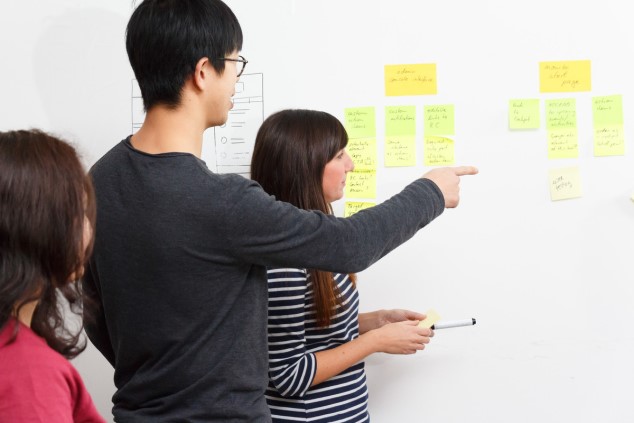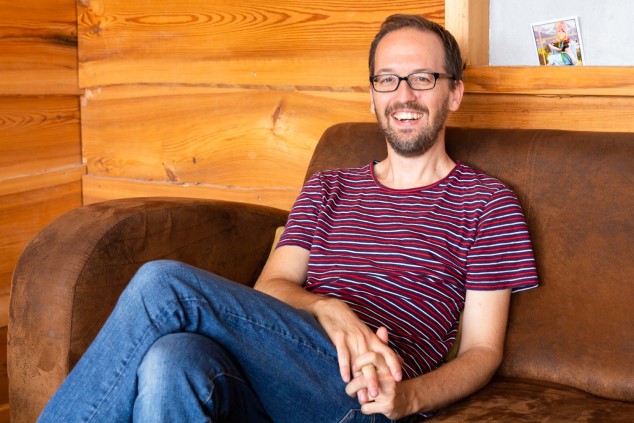In the series “Job Profiles”, we talk to various members of the InterNations team about their position and the work they do.
For this entry, we’ve had a chat with Tom, a long-standing member of our Product Management Department.

Can you briefly describe your job at InterNations?
I have been working at InterNations for seven years, and my current job title is senior product manager. As a product manager in the tech industry, you identify problems, for example with the features of a website or mobile app, listen to everyone affected, think of a solution to these problems — though not on your own — find out what exactly the developers need to work on next, support them along the way, and launch the solution you’ve all built together.
How does the product management process work from concept to launch?
You start by conceptualizing new features or changes to existing ones. In either case, they should create some sort of added value for your customers. The ideas can come from anywhere, really.
The source can be feedback from users or stakeholders, data we regularly look at, client requests — for example, via the Corporate Partnership Team and our advertising partners — or interview with users to see what they need. Once you’ve set a goal to work towards — usually that’s changing some sort of metric — you do some brainstorming with user experience and engineering. The aim’s now to come up with potential solutions to the problem at hand, discuss the various options, and pick one to start with.
You try to build this option in the most cost-efficient way possible, and think of an experiment design to test it: Will it be an A/B test? Or rather more of an A/B/C/D test? How long would this experiment need to run to get sufficient results, and so on?
When the developers have actually built the feature, you obviously have to test if it works as it should. Then the final piece of software gets launched, and you need to communicate it, internally and/or externally. Internally means informing your colleagues about the changes to the product. If you’ve released a major update or new feature, you’ll also communicate this to your customers.
For InterNations, that would be our members or different segments of the member base. Our regular members have different communication needs than the InterNations Ambassadors and Consuls, who organize regular events worldwide and may require additional features, such as our Guest List Manager.

How did you get into product management? And how has your career changed over time?
I graduated with a degree in computer science from the Technical University of Munich and started my career as a software developer. Before InterNations, I used to work for a company called Amiando, a Munich-based start-up for online event management. As the company was growing fast, they decided they needed their first product manager and asked me to take on this role — and I said yes.
Ironically, Amiando is now also part of the XING family, like InterNations. They were acquired at the end of 2010, about seven years before InterNations, and rebranded as XING Events, a platform for managing business events. That’s just a bit of a funny turn my career has taken, with me becoming part of a XING takeover twice.
Anyway, back to InterNations. At the core, my responsibilities as a product manager haven’t really changed over the years. But we’ve grown a lot as an organization, of course. Back in early 2012, we were around 40 people, maybe 45, and now we’re over 140. There’s a head of product, for example, which we didn’t even have two years ago.
In the beginning, I was the only product manager, so I was basically working on the entire InterNations product. On the one hand, this means you have a lot of impact when it comes to changing things. In theory, at least. On the other hand, your team is smaller, your resources are more limited, and in practice, your actual impact will be more limited as well.
It’s a very different kind of scope today. The team’s much bigger, but my own work has a much more sharply defined focus. I’m part of a Product Experience Team that deals with conversions — that means getting Basic Members to upgrade to our premium Albatross Membership.
Also, the way we work has evolved. I’m talking about the fundamental process, how we think of our overarching product roadmap, as well as specific product initiatives and projects.
In the beginning, we didn’t have a clear process at all, then we ended up with a whole lot of process, but by now, we’ve gone back to a less complicated way of doing things. So, we also iterate on how we develop software in the first place: I think this is quite a healthy thing for a growing organization to do, to try out different approaches.

What do you consider your biggest success at InterNations?
Actually, in product management, you often learn more from failure than from success. I remember quite a few experiments that were fun to try out, but which failed in the end.
Recently, for example, we tried to gauge interest in a new type of premium membership called “Albatross Plus”, a test that failed completely. But now the interesting part of the experiment starts: figuring out why it wasn’t successful. Are our members just not interested? Or was it due to how we designed the test? What can we learn even, or especially, from a failed experiment?
But I don’t have one big project in mind, where everything worked like a charm — unfortunately, that’s just not how it goes. However, I find my current focus really fulfilling.
When it comes to financial performance, you normally have a very clear goal in mind, you have clear metrics to track, and you can see easily how your experiments perform. When we did some iterations on our paywall — repetitive changes to optimize this product feature — we managed to increase the conversion rate by a few percent, and it’s quite satisfying to see that my work has a direct impact on business performance.
And is there any particular project you’re looking forward to?
We’re trying to make a big change in our Engineering and Product Management Departments, as we want to become a multi-platform organization. At the moment, we still have one team that focuses on developing the InterNations mobile app, while the other teams work on the web and mobile web features.
So, we’re moving into a different direction: Each team will be working on all three platforms. If you think of a new feature, you’ll have to envision it on the web, iOS, and Android at the same time, and all three versions will also be developed and launched at the same time. That’s how I think things should be, and I find it very exciting!

What do you like most about working at InterNations?
What I rather like about InterNations is that we have a truly global product. Whatever you do in product management, you need to think about a user somewhere in Australia, someone in Western Europe — let’s say, in London — and someone in South America, all simultaneously.
We don’t introduce a new feature just on the European market, for instance, and then apply it to other markets once we know it works. That’s just not what InterNations is all about. Our impact is really worldwide.
And is there anything you don’t like?
That we have a truly global product. No, seriously. Due to its nature, which I’ve just talked about, the user base is segmented into more than 400 communities around the world. But all these users don’t necessarily have the same experience — in fact, the respective InterNations Community plays a huge part with regard to user experience.
This means, in turn, that you can’t directly compare someone using InterNations in London with someone in Brisbane with someone in Buenos Aires. If you want to take this difference into account, you’d normally try to set up an experiment for Brisbane only, for example.
But this leads to rather small segments of the userbase for some communities, and that’s when you run into trouble conducting the experiment at all because you’ll never get a statistically significant amount of data in a reasonable time. So, while I love that we are by definition truly international, it also makes my own job harder.

How do you keep up to date in the field of tech product management?
Of course, I often notice what other websites and apps do when it comes to usability, user experience, and design. For example, what struck me lately about the iMessage app is that it remembers which language keyboard you’ve selected for each recipient. If I text a colleague and switch to an English keyboard for this, then text my girlfriend in German, with a German keyboard, it’ll automatically switch back to the English one the next time I message this colleague.
It’s just a small detail, and you won’t even find it in a list of features, but I think it’s very well conceived. Someone thought about how a multilingual person would use their product and built it to make their life a little easier, and it just works.
Personally, I also follow a lot of blogs on product management and product development with my news reader app, such as the German site produktbezogen. If you want to get into product development or are just generally interested, I highly recommend most articles from the Product Tank community or the Silicon Valley Product Group.
Some of their members have also written great books on related topics. My go-to recommendation is Inspired: How to Create Tech Products Customers Love by Marty Cagan, the founder of the Silicon Valley Product Group. It’s short, precise, and provides a good overview. Inspired outlines and explains the three main risks that every product manager, together with the tech lead and the user experience designer, needs to tackle: viability, value, and feasibility.
First of all, is your product or feature even viable for the company? Can you support it from a legal perspective, as well as a financial one? Does it fit into your business model? The question of feasibility refers to whether or not the engineers can build it. Nowadays, you can more or less build anything, though, so the answer is usually yes.
But still need to ask yourself if it’s valuable from a user perspective: Do your customers want to use it? And can they actually use it? This will be decided by design — visual design, interaction design, UX design, and just good design in general.
One last question: How would you explain to your children what you do at work?
My kids are now two and four years old. I don’t think that even my elder daughter quite grasps the concept yet, though. She probably thinks that daddy is just playing with computers all day long.
Image credits: InterNations/iStockphoto